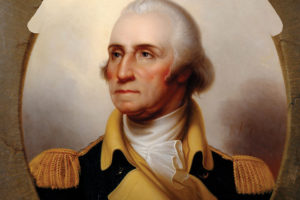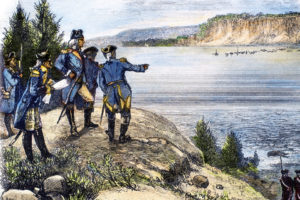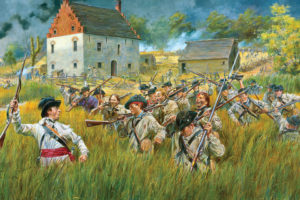Washington nearly lost the war in Brooklyn, but thanks to a clever evacuation behind a veil of fog, he ultimately bested the British.
In the spring of 1776 Lieutenant General William Howe, commander in chief of the British army in North America, faced a difficult decision. His forces had been trapped in Boston for nearly a year, besieged first by American militiamen and then by General George Washington’s nascent Continental Army. The only access to the city for supplies and reinforcements was by sea, and rebel warships and privateers prowling the approaches to Boston made life difficult for Howe’s resupply vessels. His men were on short rations, and privation gripped the populace.
 On the night of March 4 Washington directed the emplacement of artillery and several thousand troops atop Dorchester Heights, overlooking Boston. The Americans had captured the guns the previous spring from the British at Fort Ticonderoga in northern New York and hauled them to Massachusetts by boat and drawn sledge. Their position on the heights enabled Washington to command both the city of Boston and its harbor. With the heights virtually unassailable and his own artillery outranged and unable to hit the American guns, Howe made his decision: He would evacuate his troops from Boston, regroup and resupply them in the safe harbor of British-held Halifax, Nova Scotia, then hit the rebels where they appeared their weakest—in the city of New York.
On the night of March 4 Washington directed the emplacement of artillery and several thousand troops atop Dorchester Heights, overlooking Boston. The Americans had captured the guns the previous spring from the British at Fort Ticonderoga in northern New York and hauled them to Massachusetts by boat and drawn sledge. Their position on the heights enabled Washington to command both the city of Boston and its harbor. With the heights virtually unassailable and his own artillery outranged and unable to hit the American guns, Howe made his decision: He would evacuate his troops from Boston, regroup and resupply them in the safe harbor of British-held Halifax, Nova Scotia, then hit the rebels where they appeared their weakest—in the city of New York.
From the British point of view, taking New York made perfect sense. Howe and his senior commanders believed they would face a weak and disorganized army in the city, where they had more Loyalist support than they’d had in Boston. Capturing it would ensure British control of the harbor and the Hudson and East rivers, and it would geographically split the rebellious colonies. Once he’d secured New York, Howe intended to move additional troops south from Canada to “pacify” restive New England.
The Americans were equally aware of New York’s strategic importance. John Adams, the Massachusetts-born member of the Continental Congress who had nominated Washington to command the Continental Army, called the city “a kind of key to the whole continent.” Washington himself wrote of the forthcoming campaign, “It is a matter of the utmost importance to prevent the enemy from taking possession of the City of New York and the North [Hudson] River, as they will thereby command the country and the communication with Canada.” In early July, when the British attack seemed imminent, Washington rallied the soldiers in his general orders: “The fate of unborn millions will now depend, under God, on the courage and conduct of this army….We have, therefore, to resolve to conquer or die.”
But the army destined to face the British in New York comprised largely raw, untrained and untested troops. Alexander Graydon, a 24-year-old captain who found himself in charge of an ad hoc regiment sent to defend Brooklyn, across the river from Manhattan, reported he was able to recruit only 40 privates and 21 Indians in a tedious process marked by “endless care, fatigue and endless pain.” For the most part those recruited lacked discipline and equipment.
The English were already familiar with Brooklyn, having taken it from the Dutch in 1664 when it was a part of the colony of New Netherland and the city of New Amsterdam. Redcoats based in New York after the 1754–63 French and Indian War frequented the village, crossing the river for an evening’s entertainment at one of the numerous public houses, especially the Ferry Tavern at the river’s edge. Older officers called on the English-owned estates and were also welcomed to notable Dutch homes.
Understanding the importance of intelligence, Washington now sent spies to infiltrate British ranks in their Long Island military installations, Brooklyn representing the westernmost tip of that “long” island. (Most notable among American spies during the campaign was young Nathan Hale, who masqueraded as a Dutch schoolteacher but was captured by the British and hanged for treason after famously stating, “I only regret that I have but one life to lose for my country.”)
Washington directed the building of defenses against the probable British naval attack, which he presumed would come from the harbor and up the East River between Manhattan and Brooklyn. He surveyed Staten Island and set up a lookout there, facing east toward the Narrows, to provide advance warning of the British approach. He fortified Nutten [Governors] Island in the upper bay and set up artillery in the lower Manhattan defenses known as the Battery. Washington established his command post at the Cornell House, popularly known as the “Four Chimneys,” in Brooklyn Heights, atop a bluff overlooking the harbor and the East River. There, using a tall pole affixed to the roof, he devised a system of communication with subordinate commanders in Manhattan, flying flag signals by day and lanterns at night to report on British troop movements.
Meanwhile, Continental Army defenses under construction in and around Brooklyn included Fort Defiance, Fort Box, Fort Putnam (on the hills overlooking Wallabout Bay), Oblong Redoubt (aka Ring Fort), Fort Corkscrew (on a conical 60- to 80-foot height called Cobble Hill), Fort Greene and Fort Stirling. Surrounding each position was either a large ditch or redoubt connected to a line of similar entrenchments. Together the forts boasted some 30 guns, all of which faced the water.
 Though they were far from the strongest defenses, Washington believed the forts and troops manning them were ready for any British attack.
Though they were far from the strongest defenses, Washington believed the forts and troops manning them were ready for any British attack.
On the British side Howe was determined to simply overwhelm the Americans gathering to protect New York. By early July a British fleet of 130 ships carrying more than 9,000 troops lay at anchor in the lower bay, and on July 2—the very day the nascent American Congress declared the country’s independence (a declaration formally adopted on July 4)—the British began landing on Staten Island. Those who gathered along the Manhattan shoreline to observe the spectacle saw what one witness described as a “forest of masts” that made it seem “all London was afloat.” And more invaders were en route. Howe’s brother, Admiral Richard Howe, arrived a week later with 150 more ships and another 13,000 soldiers. Still more transports arrived in early August, raising the British naval presence to more than 400 ships.
Despite their numerical superiority the Howe brothers made one last attempt to arrange a peaceful solution with Washington, but the American general chose to hold on to the city, setting the stage for what would be the first pitched battle of the Revolutionary War.
By mid-August the British had amassed some 32,000 soldiers, including 8,000 Hessian mercenaries, 10,000 sailors, 70 warships and hundreds of transport vessels. British and German troops alike were supplied with the muzzle-loading Brown Bess musket, a bayonet-equipped long arm firing a .75-caliber lead ball. But the main British advantage in firepower lay in its artillery—a staggering 1,200 cannon. Most of the weapons on the American side came from militia arsenals or had been captured from the Redcoats and included, in addition to artillery, the Brown Bess, the highly accurate Kentucky (or Pennsylvania) rifle, flintlock pistols and sabers.
After weeks of suspense, on the morning of August 22 some 15,000 British troops under Lt. Gens. Henry Clinton and Charles Cornwallis crossed the Narrows from Staten Island and landed on the Brooklyn shore at Gravesend Bay, near Denyse’s Ferry (site of the present-day Verrazano-Narrows Bridge), well south of Washington’s cannons. An American chaplain, Philip Vickers Fithian, recalled the moment in his journal:
Crack! Crack! An alarm from Red Hook. Crack! Crack! Crack! The alarm repeated from Cobble Hill. Orders are given for the drums to beat To Arms. The enemy have been landing for some time down at the Narrows and, it is said, have now ashore several thousand.
Gravesend—the one town founded by English settlers in the former Dutch colony—remained largely populated by Loyalists, thus the Redcoats met only token resistance. They advanced 6 miles north that day and set up camp in the village of Flatbush, while Washington’s forces withdrew to the adjacent heights (in present-day Prospect Park). Three days later British vessels disembarked 5,000 additional troops. But Washington believed the landings to be a ruse and split his army between Manhattan and Brooklyn, with the East River between them. His assessment soon proved wrong.
On August 27—one of the loveliest days that summer, the sky dawning clear and bright after a thunderstorm—the British attacked in force.
Washington’s plan for Long Island was to defend from the high ground, his 10,000 or so troops centered on Brooklyn Heights, under the overall command of Maj. Gen. Israel Putnam, with support from Brig. Gen. William Alexander (Lord Stirling) on the heights of Gowanus and Maj. Gen. John Sullivan in the Flatbush hills.
 In the predawn darkness detachments of British troops moved up from their starting points along—from west to east—the Gowanus Road (which followed the curve of the bay north to the Brooklyn Ferry), the Flatbush Road and the King’s Highway. The first significant contact came at Flatbush Pass (later known as Battle Pass), Brooklyn’s highest natural point, where a superior force of Hessians drubbed the outnumbered Americans. While the Germans captured Sullivan, most of his men were able to retreat north across the Long Meadow and join well-trained Maryland infantrymen under Major Mordecai Gist that had dug in along a ridgeline. Under pressure from the encroaching British, Stirling also fell back. After sending most of the remaining troops across Gowanus Creek to join the main American position atop Brooklyn Heights, he and Gist led the Marylanders in a rearguard action. Despite being outnumbered nearly 10-to-1, this stalwart “Maryland 400” twice assaulted the British position at the Vechte-Cortelyou House. Washington, viewing the encounter through a spyglass from the redoubt at Cobble Hill, reportedly exclaimed, “Good God, what brave fellows I must this day lose!”
In the predawn darkness detachments of British troops moved up from their starting points along—from west to east—the Gowanus Road (which followed the curve of the bay north to the Brooklyn Ferry), the Flatbush Road and the King’s Highway. The first significant contact came at Flatbush Pass (later known as Battle Pass), Brooklyn’s highest natural point, where a superior force of Hessians drubbed the outnumbered Americans. While the Germans captured Sullivan, most of his men were able to retreat north across the Long Meadow and join well-trained Maryland infantrymen under Major Mordecai Gist that had dug in along a ridgeline. Under pressure from the encroaching British, Stirling also fell back. After sending most of the remaining troops across Gowanus Creek to join the main American position atop Brooklyn Heights, he and Gist led the Marylanders in a rearguard action. Despite being outnumbered nearly 10-to-1, this stalwart “Maryland 400” twice assaulted the British position at the Vechte-Cortelyou House. Washington, viewing the encounter through a spyglass from the redoubt at Cobble Hill, reportedly exclaimed, “Good God, what brave fellows I must this day lose!”
And lose them he did—256 of the Marylanders were killed, either cut down during the back-to-back assaults, slaughtered by the pursuing British and Hessian forces, or chased into the creek to drown. Fewer than a dozen made it safely to Brooklyn Heights. Stirling himself was captured, but the “brave fellows” had held off the British long enough to allow 300 of their countrymen to escape.
Meanwhile, in a flanking maneuver not anticipated by the Americans, the British main force under Clinton and Cornwallis had marched northeast through lightly defended Jamaica Pass, pivoted west and now threatened to roll up the defenders’ left flank.
Thus far in this first significant clash of the war the more numerous and better-trained British had outflanked, outmaneuvered and outsmarted the Americans, forcing their retreat to Brooklyn Heights, where they were effectively trapped between the Redcoats and the East River. The British almost certainly could have finished off the Americans that night and abruptly ended the war, but a cautious Howe halted his troops. Then nature intervened.
On August 28 a heavy storm rolled in, and both sides dug in to await better weather. The deluge continued through the night and into the afternoon of August 29. At that point Howe made a fatal error—electing to wait one more day to launch what he assumed would be the final attack.
Even as Howe spread the word to postpone the British assault, Washington and his commanders decided to disengage and withdraw. The heavy rains, followed by thick fog, gave the Americans the opportunity to maneuver without being observed by the British. Around noon on the 29th Washington issued orders to the quartermaster in New York “to impress every kind of water craft…that could be kept afloat and that had either sails or oars, and have them all in the east harbor of the city by dark.”
The evacuation, conducted in secrecy and silence, began about 8 p.m. that night at Brooklyn Ferry (present-day Fulton Ferry, a site abutting the Brooklyn Bridge and the shortest river crossing between Manhattan and Brooklyn). Washington ordered a rearguard to keep the fires burning atop Brooklyn Heights to dupe the British into believing the Americans remained in camp. Crewing the evacuee-filled rowboats, barges and canoes were peacetime sailors and fishermen from a recently arrived Massachusetts regiment under Colonel John Glover. After muffling the vessels’ oars with cloth, they first transported cannons, ammunition, supplies and horses. Next came the wounded. Then, through the night until just before dawn, they ferried the remaining cold, wet, defeated American soldiers across the river. The last boats pushed off from Brooklyn Ferry at 6 a.m.
The evacuation had been an unqualified success. Washington was able to save some 9,000 men—the bulk of the defensive force—as well as most of their horses, equipment and supplies. The British, for their part, had suspected nothing and were astonished when the fog finally lifted midmorning on August 30 to reveal the enemy had slipped away under their very noses.
While the evacuation enabled the Continental Army to fight again another day, the Battle of Brooklyn had taken its toll—some 300 Americans had been killed, 700 wounded and 1,000 captured. In contrast the British and Hessians reported combined losses of 64 killed and 293 wounded.
The American defeat and evacuation also allowed the British to occupy Brooklyn and impose martial law, which often constituted little more than organized looting. Many Dutch settlers, on returning to the lands they left to escape the war, found the Redcoats had reduced their homes to ashes. The occupiers used other houses as stables or to billet soldiers, and they repurposed churches and schoolhouses into makeshift prisons and hospitals for captured Americans. Careless or vengeful Redcoats tore down fences, trampled gardens and destroyed what crops they could not use. Torrential rains subsequently turned Brooklyn’s few roads into impassable mud holes, which suffered further under the passage of heavy British gun carriages and supply wagons.
That autumn a deadly fever swept through the British encampment, while those who dodged the fever suffered from a range of other illnesses. But conditions were far worse for the American prisoners, most of whom the British had crammed aboard prison ships anchored in Wallabout Bay. Scarcely half of them survived their captivity. Indeed, during the war more than 11,000 American prisoners, most in their 20s and early 30s, would die from starvation and disease—a number far exceeding the 6,800 total American combat casualties.
Although the Battle of Brooklyn had ended in an American defeat, the intrepid Continental Army fought on until the defeated British ultimately undertook their own humiliating departure from New York on Nov. 25, 1783—an event still celebrated as Evacuation Day.
New York–based writer Norman Goldstein is a regular contributor to Military History. For further reading he recommends The Battle for New York, by Barnet Schecter, and The Battle of Brooklyn, 1776, by John J. Gallagher.
First published in Military History Magazine’s November 2016 issue.





